

The first type of penalty is the pre-snap penalty. Now that you understand the 3 phases of throwing a flag let’s learn why referees throw flags throughout the football game.ġ0 Get Access Now Pre-Snap Offensive Penalties These penalties will often result in a 15-yard penalty for the guilty team. Dead ball means that the play is over, and the ball is dead. Referees will throw a flag and mark it as a “dead ball” penalty. These penalties are often related to unnecessary roughness.

After The Play PenaltyĪfter the ball carrier is tackled and the play is officially over, there are still penalties that can occur. To learn more about each referee on the field and their duties, we recommend you read here. If a penalty is identified, they will blow the whistle and stop the ball from being snapped. If any penalties occur during the play, it’s their job to throw the flag.įor example, the line judge is responsible for any pre-snap penalty on the line of scrimmage. During The Play PenaltyĪfter the ball is snapped, there are multiple rules that are now into play.Įach referee has a location on the field for which they are responsible. On defense, it’s important to watch the football and make sure it’s snapped to the quarterback before coming across the line of scrimmage. To avoid pre-snap penalties on offense, it’s important to learn the cadence of the offense and move when the ball is snapped. Defensively, pre-snap penalties often occur when a defensive player crosses the line of scrimmage before the ball is snapped. These penalties are often movement penalties, as only one offensive player may be moving in motion once the offense is set. Pre-Snap PenaltyĪ pre-snap penalty is any illegal action or movement before the ball is snapped from the center to the quarterback. Let’s learn more about these three phases. To understand why the referee throws a flag, you must understand the 3 phases of a football play. There are 3 phases when the referee may throw a flag. The yellow flag in football, which is a cloth that typically has rocks or counterweight at the other end, is thrown by referees when they identify a penalty. Before we start breaking down the penalties in football, it’s essential to learn why referees throw a yellow flag.


 0 kommentar(er)
0 kommentar(er)
